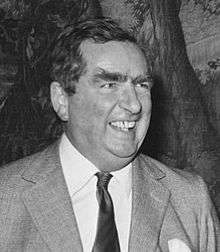Labour Party (UK) leadership election, 1980
Labour Party (UK) leadership election

|
| 4 November 1980 (1980-11-04) |
|
|
| |
.jpg) |
 |
| Candidate |
Michael Foot |
Denis Healey |
| First Round Votes |
83 |
112 |
| First Round Percentage |
31.3% |
42.3% |
| Second Round Votes |
139 |
129 |
| Second Percentage |
51.9% |
48.1% |
|
| |
 |
 |
| Candidate |
John Silkin |
Peter Shore |
| First Round Votes |
38 |
32 |
| First Round Percentage |
14.3% |
12.1% |
| Second Round Votes |
- |
- |
| Second Percentage |
- |
- |
|
|
|
The British Labour Party leadership election of 1980 was held following the resignation of James Callaghan. Callaghan had been Prime Minister from 1976 to 1979 and had stayed on as leader of the Labour Party for eighteen months in order to oversee an orderly transition to his favoured successor, Denis Healey over his own deputy Michael Foot. However, during this period the party had become bogged down in internal arguments about its procedures and future direction.
Initially, the candidates were thought likely to be Denis Healey, Peter Shore and John Silkin, but Michael Foot was persuaded to stand by left-wingers who believed that only he could defeat Healey.
Candidates
Results
The result of the first ballot of Labour MPs on 4 November was as follows:[1]
In the second ballot, held six days later, there was a run-off between Healey and Foot.[1]
| Second Ballot: 10 November 1980 |
| Candidate |
Votes |
% |
|
|
Michael Foot |
139 |
51.9% |
|
Denis Healey |
129 |
48.1% |
|
| Majority |
10 |
3.8% |
|
| Turnout |
268 |
|
|
Foot elected |
|
This was the last leadership election to be conducted amongst Members of Parliament only, an electoral college was subsequently introduced for future contests.
References
Bibliography
- Twentieth-Century British Political Facts 1900-2000, by David Butler and Gareth Butler (Macmillan Press, 8th edition 2000)
|
|---|
|
|
|
| Internal elections |
|---|
| | Leadership elections | |
|---|
| | Deputy Leadership elections | |
|---|
| | Shadow Cabinet elections | |
|---|
|
|
|
|
.jpg)

